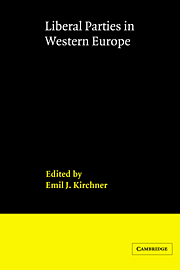Book contents
- Frontmatter
- Contents
- List of tables
- List of diagrams
- List of maps
- Notes on the contributors
- Preface
- 1 Introduction
- 2 Between left and right: the ambivalence of European liberalism
- 3 Two roads of Italian liberalism: the Partito Repubblicano Italiano (PRI) and the Partito Liberale Italiano (PLI)
- 4 The FDP in the Federal Republic of Germany: the requirements of survival and success
- 5 Great Britain — social liberalism reborn?
- 6 Liberalism in France
- 7 Liberal parties in the Netherlands
- 8 The Belgian liberal parties: economic radicals and social conservatives
- 9 The Freiheitliche Partei Österreichs: protest party or governing party?
- 10 The Swedish Liberal Party: The politics of unholy alliances
- 11 Liberalism in Denmark: agrarian, radical and still influential
- 12 The Norwegian Liberal Party: from political pioneer to political footnote
- 13 Liberal parties in Finland: from perennial coalition actors to an extra-parliamentary role
- 14 Liberal parties in Switzerland
- 15 The Luxemburg Liberal Party
- 16 Identifying liberal parties
- 17 Ambivalence revisited: an analysis of liberal party manifestos since 1945
- 18 Transnational links: the ELD and Liberal Party Group in the European Parliament
- 19 Western European liberal parties: developments since 1945 and prospects for the future
- Index of political parties
- General index
9 - The Freiheitliche Partei Österreichs: protest party or governing party?
Published online by Cambridge University Press: 16 November 2009
- Frontmatter
- Contents
- List of tables
- List of diagrams
- List of maps
- Notes on the contributors
- Preface
- 1 Introduction
- 2 Between left and right: the ambivalence of European liberalism
- 3 Two roads of Italian liberalism: the Partito Repubblicano Italiano (PRI) and the Partito Liberale Italiano (PLI)
- 4 The FDP in the Federal Republic of Germany: the requirements of survival and success
- 5 Great Britain — social liberalism reborn?
- 6 Liberalism in France
- 7 Liberal parties in the Netherlands
- 8 The Belgian liberal parties: economic radicals and social conservatives
- 9 The Freiheitliche Partei Österreichs: protest party or governing party?
- 10 The Swedish Liberal Party: The politics of unholy alliances
- 11 Liberalism in Denmark: agrarian, radical and still influential
- 12 The Norwegian Liberal Party: from political pioneer to political footnote
- 13 Liberal parties in Finland: from perennial coalition actors to an extra-parliamentary role
- 14 Liberal parties in Switzerland
- 15 The Luxemburg Liberal Party
- 16 Identifying liberal parties
- 17 Ambivalence revisited: an analysis of liberal party manifestos since 1945
- 18 Transnational links: the ELD and Liberal Party Group in the European Parliament
- 19 Western European liberal parties: developments since 1945 and prospects for the future
- Index of political parties
- General index
Summary
introduction
The subject of this essay is the Freiheitliche Partei Österreichs (FPÖ), traditionally translated into English as the Freedom Party of Austria. It is a party with numerous internal contradictions, especially of an ideological nature. For years after its launch in 1956, it was almost universally reviled in Austria as a party of old Nazis. In 1979 it joined the Liberal International and now wishes to be known in English as the Liberal party of Austria. In 1983, the FPÖ commenced its first ever period of federal governmental office, and in a coalition with the Socialists at that.
This essay seeks to explain the FPÖ's transition from a party of protest to a party of government. First, it will show that the FPÖ's contradictions are a hallmark of the political tradition from which it derives. Secondly, it will examine the current tensions and conflicts in the FPÖ's organisation. Thirdly, I shall look at the party's often precarious electoral situation, concentrating in particular upon the profile of its protest voters, who have traditionally constituted a substantial proportion of the FPÖ's electoral support. Then, I shall outline the programmatic development of the party, with special reference to the most recent developments in the relationship between the FPÖ's national and liberal traditions. The penultimate section of this paper will concentrate upon the party's experience in government. Here the party appears to have had some success in one of its major objectives, namely to start reducing the influence of Austria's very powerful and ubiquitous system of Proporz (the party-political allocation of public offices).
- Type
- Chapter
- Information
- Liberal Parties in Western Europe , pp. 213 - 251Publisher: Cambridge University PressPrint publication year: 1988
- 7
- Cited by



